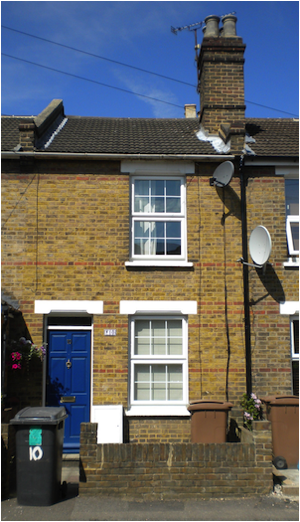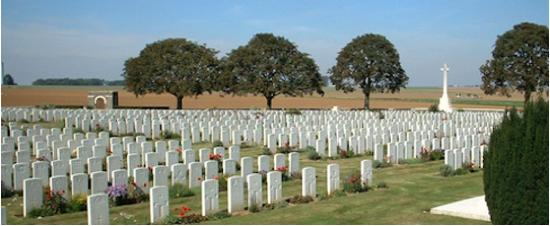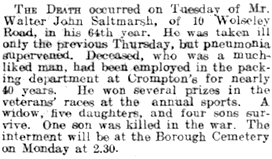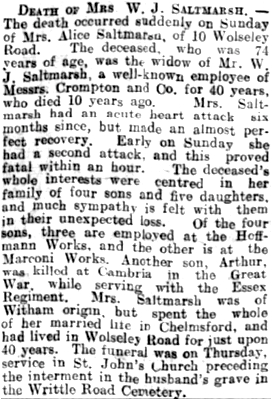Arthur Saltmarsh was one of 13 children, born and raised in the Moulsham area of Chelmsford. Prior to joining the Essex Yeomanry in February 1916 he worked at the Hoffmann’s bearings factory in Chelmsford and finally at the town’s Crompton’s factory where his father worked for more than 40 years. He was moved to the Essex Regiment in December 1916 and was fatally wounded at the Battle of Cambrai in November 1917. His home was in Wolseley Road. An uncle was killed during the war and a nephew likewise in the Second World War.
SALTMARSH, ARTHUR,
Private, 1st Battalion Essex Regiment (formerly of the Essex Yeomanry)
Meanwhile, Battalion headquarters and X Company had at 10 a.m. started up the main Cambrai road through Masnières with a view to taking up their position in front of the German line north of the town, but again machine gun and rifle fire from the main road stopped them, shooting taking place from the housetops on either side of that thorough-fare. The fire was hotly returned and the snipers silenced,
As the enemy trenches were reported clear, the Company moved forward again. The men had just reached the wire when a surprise local counter attack was launched, which resulted in stiff fighting. Finding that further process was impossible, the men were withdrawn to the west of the village to feel their way round, for it was imperative that there should be no delay in the advance.
The headquarters of the Essex and X Company, not being able to make their positions east of the Cambrai road, covered the advance of the 87th Brigade. That movement, however, also ceased owing to the resistance at the vital point on the road. headquarters then marched along the canal bank to a position near the Sugar Factory, got in touch with Brigade headquarters and awaited orders.
The Germans having withdrawn from Masnières, the Battalion ultimately dug-in between the Masnières-Rumilly and Masnières-Cambrai roads; Hampshires on the right and South Wales Borderers west of the Cambrai road. By 8.30 p.m. all companies were reported present on the new line north of Masnières.
A feature of the fighting was the mixing of civilians with the military forces. The surprise of the attack had prevented the Germans evacuating inhabitants of the villages, so that as soon as Marcoing and Masnières were occupied, the roads south were dotted with straggling groups of fugitives and their humble belongings.
The Battalion casualties in the two days’ operations were three officers and 21 other ranks killed and two officers and ten other ranks wounded., whilst one officer and 31 men were reported missing. As they dug in the men, full of hope, could see the spires of Cambrai in the distance. the counter-offensive had, however, yet to come.”
Among those who died from wounds on 21st November 1917 was Arthur, aged 23. Arthur is buried at Rocquigny-Equancourt Road British Cemetery, Manancourt, Somme in France (grave: II. D. 19), some 15 miles from Masnières. The cemetery was used mainly by the 21st and 48th Casualty Clearing Stations posted at Ytres.

Arthur was born in New Writtle Street, Chelmsford in 1894, the son of Walter John Saltmarsh (Dockrrill at birth) and Alice Saltmarsh (nee Fisher). Arthur’s father had been born in 1863 in New Writtle Street, Chelmsford; his mother in 1862 in Chipping Hill, Witham. They had married at Chelmsford Register Office on 23rd January 1884 and by 1891 were living at 14 New Writtle Street, Chelmsford.
Arthur’s dozen siblings, all Chelmsford-born were: Florence Ada ‘Florrie’ Saltmarsh (born in 1884, baptised at St. John’s Church, Moulsham on 5th May 1888), Walter Saltmarsh (born in 1885 in New Writtle Street, baptised at St. John’s Church, Moulsham on 5th May 1888, and died 1963), Harry Saltmarsh (born in New Writtle Street in 1887, baptised at St. John’s Church, Moulsham on 5th May 1888 and died 1959), Alice Saltmarsh (born in 1888, baptised at St. John’s Church, Moulsham on 30th January 1889 and died in 1889), Nellie Elizabeth Saltmarsh (born in 1889, baptised at St. John’s Church, Moulsham on 30th November 1889 and died in 1972), Katie Saltmarsh (born in 1892, baptised at St. John’s Church, Moulsham on 2nd April 1892, also died in 1892), Frederick Charles Saltmarsh (born in New Writtle Street in 1893 and died in 1965), Minnie Saltmarsh (born in New Writtle Street in 1895, baptised at St. John’s Church, Moulsham on 15th March 1896, at which time her father was a labourer of 27 New Writtle Street, and died 1967), Daisy Saltmarsh (1898-1904), Rose Saltmarsh (born in Wolseley Road in 1899), Edward George Saltmarsh (born in Wolseley
Road in 1901) and Dorothy May Saltmarsh (born in Wolseley Road in 1903 and died in 1993).
Arthur was baptised at St. John’s Church, Moulsham on 4th November 1899, along with his siblings Frederick Charles Saltmarsh, Minnie Saltmarsh, Daisy Saltmarsh and Rose Saltmarsh. At the time their father was a labourer of New Writtle Street. Interestingly, that day saw 18 christenings carried out at St. John’s Church.
At the turn of the century Arthur’s family moved from 14 New Writtle Street to a street nearby, Wolseley Road. His parents were to remain there until their deaths.
The 1901 census found six year-old Arthur with his parents and eight siblings at 10 Wolseley Road. Arthur’s father was employed as en engineer’s labourer. His sister Florrie was general servant, brother Walter was a stable boy, and brother Harry was an errand boy for a bookmakers. Thomas Fewell, who was also to lose his life in the war, was living two doors away at 8 Wolseley Road.
On 29th August 1903 Arthur's brother Edward George Saltmarsh was baptised at St. JOhn's Church, Moulsham, one of four children from Wolseley Road baptised there that day. The others baptised that day from Wolseley Road included brothers of three other men commemorated at Chelmsford - Charles William Fewell, Thomas Richard Fewell and John Harold Cook.
In 1911 16 year-old Arthur was recorded in the 1911 census living with his parents and seven siblings, still at 10 Wolseley Road and employed as an engineer’s labourer at Hoffmann’s ball-bearing works in Chelmsford. By then his parents had been married 27 years and had ten of their thirteen children still alive. Arthur’s 47 year old father was an engineer’s labourer at Crompton’s electrical engineers; his brother Walter was a grinder at Hoffmann’s; while another brother Harry was an engineer’s clerk in an electrical engineer’s; and another brother Frederick was an engineer’s labourer also at Hoffmann’s. Arthur later worked at the electrical engineering firm of Crompton’s in Chelmsford.
Arthur’s uncle, Christopher Edward Saltmarsh was killed in 1914 while serving with the Royal Fusiliers and is commemorated on the Civic Centre Memorial, Chelmsford.
Arthur enlisted in Chelmsford, around 14th-15th February 1916 and served as Trooper 2624 in the Essex Yeomanry. He was one of a large number of men transferred from 3/1st Battalion of the Essex Yeomanry to the Essex Regiment in December 1916 - others included Robert Acfield Gibbons and Douglas Havelock Newman, both of whom are commemorated at Chelmsford.
Arthur subsequently served in France as Private 34155 in the 1st Battalion of the Essex Regiment which formed part of the 88th Brigade in the 29th Division. The battalion had, from July 1916 until November 1916, fought in the Battle of the Somme. By April 1917 it had left the Somme area and moved northwards to participate in the Battle of Arras in Pas de Calais France.
The battle commenced on Easter Monday, 9th April 1917 when Allied troops launched an offensive along a wide front which despite early progress failed to achieve the breakthrough they coveted. Arthur’s battalion suffered very heavily during the battle when, on 14th April 1917, it attacked Infantry Hill from the village on Monchy-le-Preux, east of Arras. The battalion went into action with 31 officers and 892 other ranks, of who at the end of the day 17 officers and 644 other ranks were reported to be either killed, wounded or missing. Arthur appears to have been one of the minority who survived.
In November 1917 Arthur’s battalion participated in the Battle of Cambrai when the British mounted a major attack on German positions south-west of the French town of Cambrai. Initial British gains were later reversed by German counter-attacks by the time the battle ended in early December 1917.
The battle, famous for the first large scale successful use of tanks, commenced on the morning of 20th November 1917. In the early hours the 1st Battalion of the Essex Regiment had marched five miles from Fins to its assembly position at Gouzeaucourt near Villers-Plouich. From there it advanced as far as the canal at Masnières by nightfall, about five miles short of Cambrai. A post-war history of the battalion takes up the story:
“At nightfall several mopping-up parties were despatched across the canal to clear out snipers. A party of the Essex, under Lieuts. Curzon, Hope and Vaughton, crossing by the lock to the west of the town [Masnières], co-operated with the Newfoundlanders in clearing up as far as the main Masnières-Cambrai road, returning by 3 a.m. on the 21st. By mean sof the same lock Y and Z companies moved off at 3.45 a.m. to form a bridge-head, and occupied the railway running between Masnières and Marcoing.
At 4 a.m. the Intelligence Officer (2nd Lieut. Miles), with scouts, reconnoitered the selected position. He reported on his return at 8.30 that the enemy were still in possession of the town, Y and Z Companies having dug in along the railway in touch with the Newfoundland Regiment. W Company were sent across the canal in support of the two companies at 9 a.m.. patrols being instructed to reconnoitre to the east of the Cambrai road, and should the front trenches of the Masnières-Beaurevoir line be found unoccupied to establish themselves therein. A combined attack of the 87th and 88th Brigades was planned for 11 a.m. to capture that line.
Fifty minutes later, in the course of the movement. W Company was held up west of the Cambrai road, having found it impossible to get scouts across the way. At this juncture tanks were observed moving in an easterly direction from Marcoing along the ridge towards Masnières, the van of the attack of the 87th Brigade. W Company endeavoured to advance parallel to the tanks in a north-easterly direction, but were stopped by machine gun fire from the Cambrai road, and, being unable to make progress, they formed a linke on the southern slope of the ridge in prolongation of that of the South Wales Borderers.

On 25th January 1918 the Essex Weekly News reported:
“Pte. Arthur Saltmarsh, Essex regt., son of Mr. and Mrs. W. J. Saltmarsh, 10, Wolseley-rd., Chelmsford, was killed in action on Nov. 21 during the Cambrai advance, Prior to joining the Colours deceased was employed in the lamp department of Messrs, Crompton and Co., Ltd. He was 23 years of age and single. He answered the call when the County were appealing for men for the Essex Yeomanry, Two days before his death he wrote that he had obtained leave and would be home during the month.”
The same day’s Essex County Chronicle reported:
“Mr. and Mrs. W.J. Saltmarsh, of 10 Wolseley Road, Chelmsford, have now received official intimation that their son, Pt. Ar. Saltmarsh, Essex Regiment, previously attached to the Essex Yeomanry, reported wounded on Nov. 21 last, was killed in action on that date, near the Cambrai front. Deceased was 23 and unmarried.”

Arthur is commemorated on the Civic Centre Memorial, Chelmsford, on the Essex Yeomanry War Memorial at Chelmsford Cathedral, and at the London Road Congregational Church, Chelmsford (he had been a member of the latter church’s Sunday School). He was not commemorated by the war memorial at St. John’s Church in Moulsham Street.
On 22nd November 1918 the Essex County Chronicle published the following in memoriam notice:
'Saltmarsh. - In loving memory of Pt. Arthur Saltmarsh, Essex Regt., aged 23, who was killed in action, Nov. 21st, 1917, at Cambrai. From his loving Mother, Father, Sisters, and Brothers, of 10 Wolseley Road, Chelmsford.
‘God takes our loved ones from our homes, but never from our hearts.’”
The same day’s Essex Weekly News included another in memoriam notice from Arthur’s brother Walter:
“In loving memory of Pte. A. Saltmarsh, machine gunner, 1st Essex Regt., who was killed in action Nov. 21st, 1917, in the battle of Cambrai.
One of the dearest, one of the best. Now in God’s keeping, safe at rest. Proudly he answered his country’s call; His life he gave for one and all.
- From his brother Walter, 8, Wolseley-rd., Chelmsford.”
Arthur’s parents were still listed at 10 Wolseley Road in the 1918 register of electors, while brother Walter and his wife Frances Kate were at number 8.
Arthur’s elder brother Harry had married Ethel F. Orin in 1911. Among their children was Christopher Edward Saltmarsh, nephew of Arthur, who was to die from wounds on 23rd January 1945 in Germany during the Second World War.
Arthur’s father died on 2nd April 1927, aged 63 at 10 Wolseley Road; his mother died there in 1937, aged 74. Arthur’s parents had regularly placed in memoriam notices in Chelmsford’s newspaper until their deaths.
Acknowledgements to Ian Miller and Wendy Cummin
150419
